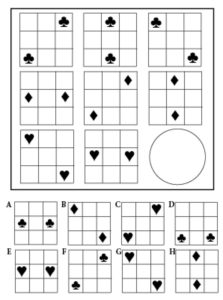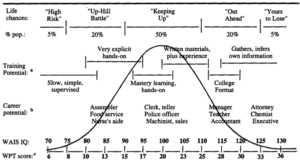This question was posted recently on Quora at: https://intelligenceandiq.quora.com
Before answering, I wish to remind you that although IQ is the best measure of intelligence that we have, it’s not perfect. Some people who have taken IQ tests on different occasions and under professional supervision have obtained significantly different scores on those occasions. Performance on an IQ test, like performance on any test, is subject to many factors, including your mood, alertness, and motivation on the day you took the test. It also depends on how much practice you’ve had in completing items that require pattern recognition. Consequently, you should recognize that any IQ score you’ve obtained should be regarded as an approximate measure of your intelligence. It doesn’t measure your creativity or your ingenuity, although these may be positively correlated to your intelligence.
To create items that would be scored objectively, psychologists developed multiple choice tests with only one correct answer. Furthermore, to make the items purely visual, language-independent, and free of knowledge favoring any particular culture, they developed pattern-recognition items known as Progressive Matrices.
What does a Progressive Matrices IQ Test Item Look Like?
An IQ test typically consists of either 48 or 60 items, presented in order of increasing difficulty and is time-limited to about 40 minutes. Usually, an item consists of an array of 3 × 3 grids, called matrices, arranged in 3 rows and 3 columns. As you scan the 3 matrices from left to right in a particular row, you are expected to determine how each matrix is derived from the one on its left. Sometimes, there will also be a relationship among matrices in the same column, in which case you must ascertain how each matrix is derived from the one above it. Answering an item correctly involves choosing the matrix or matrices that complete the pattern or patterns evident within the progression from left to right and/or top to bottom.
In the sample item below, examine how the matrices change as you scan from left to right along the top row of the display. Then look for a pattern in how the matrices change in the middle row. Did the matrices in both rows change the same way?
Now, do the same for the matrices in each of columns 1 and 2 as you move from top to bottom. Did the matrices in both the rows and columns change the same way? If so, apply the same change to the second matrix in the bottom row and the second matrix in the third column to obtain the correct grid from the offerings “A” to “H” that belongs in the circle.
Sample Item: Select the option, A through H, that belongs in the circle below to complete the pattern. (Try this before reading ahead.)

As you moved from left to right across the top row, you probably observed that the line joining the clubs rotated 45˚ counterclockwise. This rotation was also evident in the second and third rows, enabling you to determine that answer C continued the pattern and is therefore, the correct answer.
The IQ of a person who takes an IQ test is calculated from the number of items answered correctly. However, to many people, an item such as the sample item above seems rather academic and unrelated to tasks in real-life contexts. Consequently, many regard IQ as a measure of book-learning skills–skills perceived to be irrelevant in the everyday world of work. Yet, such tests are used extensively for the selection of job applicants in business and industry, and for recruitment in the military. Why?
In her article Why g Matters, psychologist Linda Gottfredson observes:
Research in job analysis and personnel selection refutes the claim that g [measured as IQ] is useful only in academic pursuits. Intelligence turns out to be more important in predicting job performance than even personnel psychologists thought just two decades ago…The key observation here is that personnel psychologists no longer dispute the conclusion that g [i.e., IQ] helps to predict performance in most if not all jobs.
In supporting her assertion of a close connection between IQ and job performance, Gottfredson compiled information from the Wonderlic Personnel Test and Scholastic Level Exam to create the display in the figure below.

The row labeled career potential shows the spectrum of employment ranging from routine, relatively unskilled occupations at the low IQ levels to the occupations demanding complex cognitive skills at the high IQ levels. As we move from left to right along this employment spectrum, we see that the level of job complexity increases in parallel with the corresponding IQ scores. It is not surprising that the increasing levels of complexity in the jobs match the increasing levels of complexity in the items on the IQ tests.
What can a person of IQ 160 do that a person of IQ 100 Cannot?
The graph above hints at the answer. As patterns become more complex, those of high IQ have an ability to “connect the dots.” That is why Einstein was able to look at the equations in classical physics, see the asymmetry in the interpretation of Maxwell’s equations, and then in a leap of insight, recognize that time is not absolute. Such insights, rarely if ever come from someone of average intelligence.
